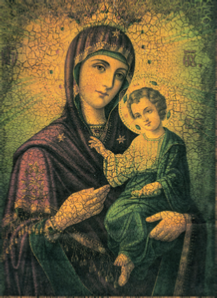Mention of the word IKON (Icon) to the modern computer literate evokes a recollection of ICE (Icon Controlled Environment), GEM (Graphics Environment Module), Windows or Android operating systems -according to the generations in which the learning has taken place. Little pictures are displayed on the screen and when they are ‘clicked on’ a programme or other operation is commanded to start.
However, the word has a more traditional meaning. An Icon (or Ikon - from the Greek) is a likeness or image painted on wood or possibly in low relief sculpture or even a mosaic. It describes a religious subject, frequently our Saviour, the Virgin Mary and Child, an Apostle or Saint. The depiction is often rendered with precious gold leaf and is the object of veneration in the Eastern Orthodox Church tradition. There are a great many ikons in existence, being part of the sacred art of Russia, Greece and elsewhere in that part of the world. They commonly are seen in the streets of towns and villages as well as in the churches. The Coptics of Egypt also display them.
Generally the Western Churches have, in the past been against their display and use, believing them to be ‘Graven Images’ not to be worshipped and the practice of their veneration being a form of idolatry. The Puritans of the 16th and 17th Centuries engaged in wholesale destruction of such pictorial or sculptural ornament, including stained glass, both within and outside churches and cathedrals.
Recently, in Portsmouth Cathedral, a Romanian teacher - Carmen Ramona Orastean - exhibited some of the Ikons which she had devised using traditional methods. She insists that the pictures are written rather than painted on account of the deep theological messages which they convey. To be seen are:
The Nativity
The Virgin of Vladimir
Virgin and Child
The Pantocrator (Almighty God)
The Archangel Michael
The Resurrection (Anastasis)
St Nicholas
St George
- most of these are derived from Russian or Greek originals. Unusually the one of St George shows him on a black horse instead of the more normal white one. Depiction of St Nicholas is thought to be that of who has come to be known in the west as Santa Claus.
Rod Dawson





